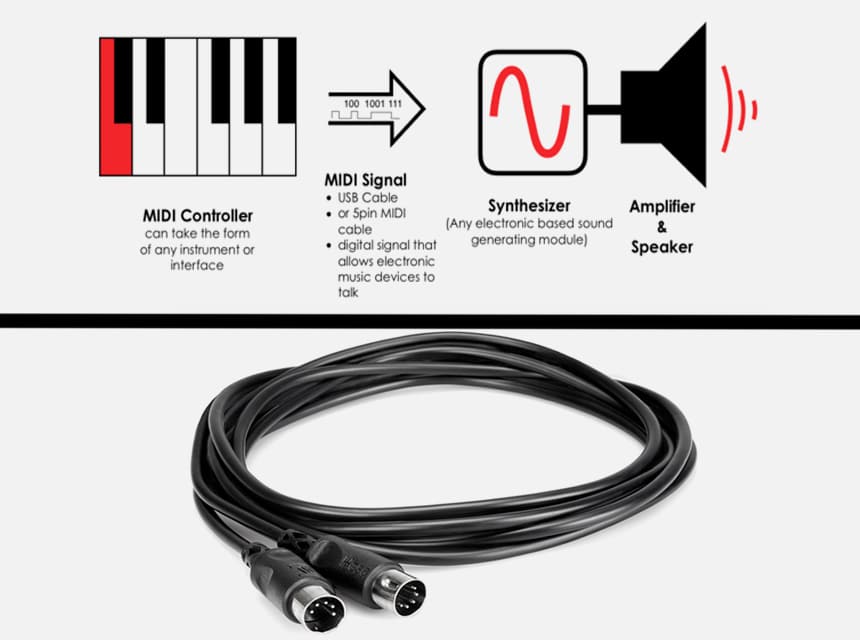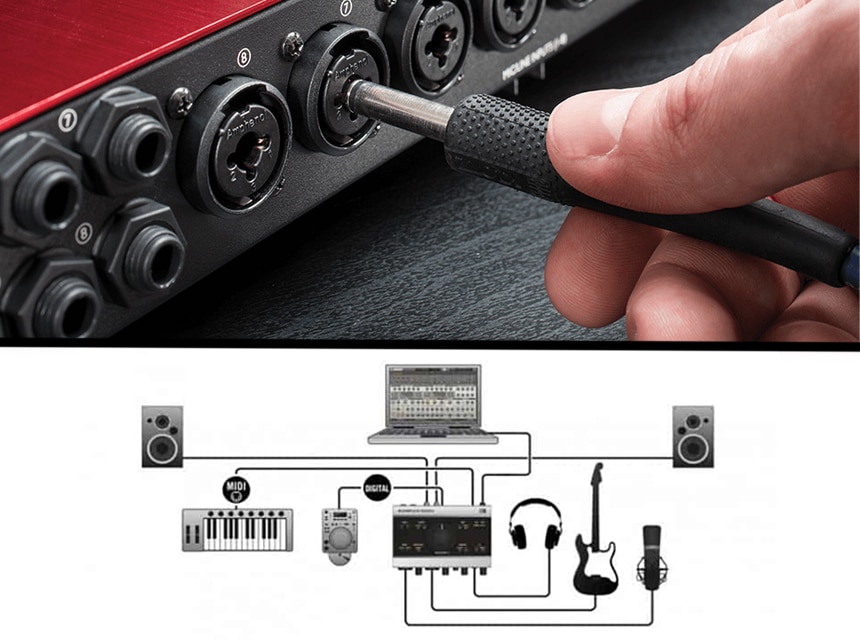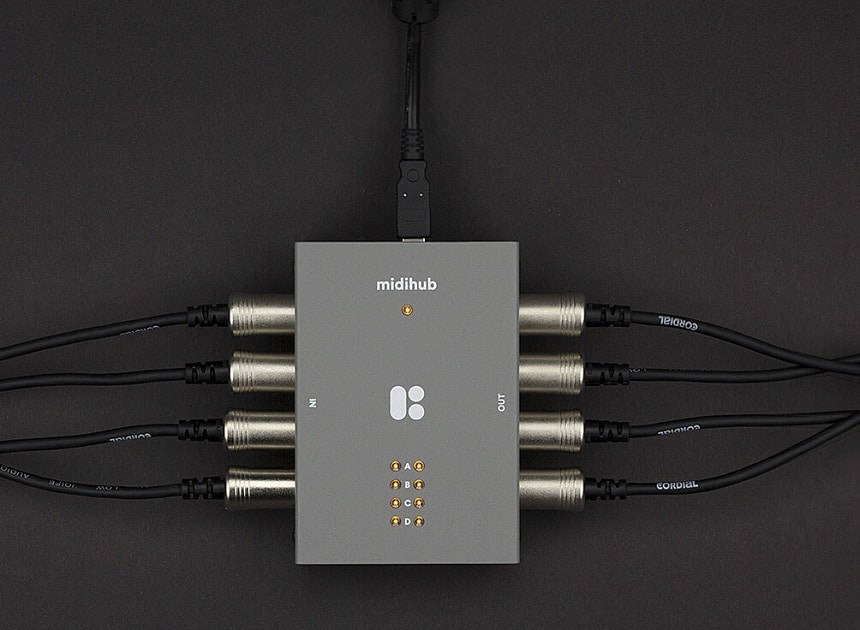In this guide, we’re looking into how to connect a midi keyboard to an audio interface and giving you a step-by-step guide to connecting your keyboard. There are a number of benefits to doing this, as it can reduce the latency in any recording or performance, or allow you to keep your USB slots free for other things.
There are so many options in the world of music and music technology, and usually, more than one way that you can do something. This is the same for MIDI keyboards. In the majority of cases, you could simply plug your MIDI keyboard straight into your computer, but this is not always the wisest choice. Though many MIDI keyboards (certainly the more modern ones) come with MIDI-USB capability so you can just use a USB cable, you may not want to connect in this way, and having another method can allow you to use your inputs for other audio sources.

MIDI is an acronym. It stands for Musical Instrument Digital Interface Trusted Source MIDI - Wikipedia MIDI (/ˈmɪdi/; an acronym for Musical Instrument Digital Interface) is a technical standard that describes a communications protocol, digital interface, and electrical connectors that connect a wide variety of electronic musical instruments, computers, and related audio devices for playing, editing and recording music. en.wikipedia.org . This technology was first developed in the early 1980s as a way to allow different musical equipment to “communicate” and connect in new and exciting ways. For instance, you may have had a keyboard and wanted to send the signal to a synthesizer module. MIDI allowed this connection between two pieces of kit that weren’t even made by the same brand. This led to the MIDI cable being one of the most important pieces of equipment in a musician’s studio.
MIDI data can also be saved within a file. You can then load this to trigger sounds within your software.
The potential of MIDI was clear from day one and it is now used in a huge amount of equipment, including many keyboards.
The design of each MIDI keyboard and the MIDI controller will probably be slightly different, but it is industry-standard for the outputs to sit at the back of the keyboard or controller. These should be labeled. You will ordinarily see that there is:
When you buy a MIDI keyboard, it may come with a signal diagram. This enables you to see where the audio is going to be sent, and where both the relevant inputs and outputs are. In almost all MIDI keyboards made in the modern age, connections for both MIDI and USB are in place, so you need to decide which is the most suitable for you.

Having stated the fact that most of the MIDI equipment out there can be connected directly to a computer, what is the point of an audio interface? Why go to the effort of connecting your keyboard through a USB or Thunderbolt interface? There are a couple of main reasons:
An audio interface is also a way that you can combine the audio signals from two sources. For instance, if you want to both sing and play piano at the same time, you can run the audio signal through one of the inputs, and the MIDI signal through another. These can feed into a DAW at the same time and you can record multiple sources. If you were to connect a USB mic and a USB keyboard to the same computer there is every chance you will have issues with inputs and with delay and latency.
So, how do you connect MIDI cable from the keyboard to the audio interface? There are multiple methods of connecting your MIDI keyboard and a few different setups that are commonly used by musicians and studio engineers. We’ve explained each of these ways below.
The first method to connect a MIDI keyboard to an audio interface is via a MIDI cable. MIDI cables were first introduced in the 1980s around the advent of this technology, so you can still use some pretty old keyboards and even synthesizers to send MIDI signals. A MIDI cable into a USB interface is one of the best ways to connect this older equipment and might be your only choice.
The steps are simple.
This isn’t necessarily the most popular way of connecting MIDI keyboards in the modern age, there are some different options.

A MIDI hub is a slightly different method. A MIDI hub is another word for a MIDI interface that doesn’t necessarily have “audio” capabilities. It may solely focus on sending MIDI signals or allowing you to connect multiple MIDI devices into one central hub and then use the signal. Most budget audio interfaces have an option to input MIDI, but there may only be one input. A MIDI hub can have numerous inputs, allowing you to choose which MIDI signal you want to use for any given project.
To connect via a MIDI hub:
When is a MIDI hub a good idea? Well, you might have a home studio with a lot of different MIDI-capable equipment. Because of the fact that MIDI is something of an industry standard (and has been since the 1980s) it is possible that you will have keyboards, drum pads, and more. You can easily switch between them without having to unplug equipment and plug other gear back in.
This is, without doubt, the simplest way to take MIDI signal and get it into a computer, so if you are trying to use software solutions rather than sending signals to lots of different MIDI hardware, the USB method is the best.
If you are buying a MIDI keyboard that can do this, keep an eye out for models that are USB-MIDI compatible. This will be stated in the product description, and what it means is that the MIDI signal can be carried via a USB cable. You can use a USB A to B cable to carry the signal.
It is also worth looking into other equipment, too. For instance, a lot of Mac users don’t use USB, instead using the faster Thunderbolt connection to carry the signal.
Either method involves using a DAW or a “digital audio workstation”. You can use something simple like Garageband, which comes free with Apple devices.
To connect via USB cable and DAW:
As you can see, this method is one of the simplest out there. MIDI signal is sent directly into your DAW. If you are looking for a portable setup then you don’t need to carry an interface around with you to connect your MIDI keyboard. That said, it has its downsides, too. You’re relying on the product having an excellent driver and being able to communicate with minimal latency.
This is one of the questions people often have if they are new to audio interfaces, MIDI keyboards, and producing music. MIDI and audio are separate signals. Some MIDI keyboards can produce audio as well, but most do not have a sound module that generates a sound. Instead, you are relying on your DAW and virtual instruments Trusted Source What Are VST Plugins and What Do They Do? VST plugins are capable of emulating instruments and effects hardware for a fraction of the price from inside your favorite digital audio workstation. www.lifewire.com to make the sound itself.
MIDI just carries data. Your keyboard (or other equipment) may have the ability to turn this data into hard audio, or you may have to send it to a computer or another sound module.
In the world of music, there are always a few ways to achieve the same end result. When you have a keyboard with MIDI compatibility, you have the option to connect it via an audio interface, or you may even be able to connect it directly to the computer. Our guide on how to connect a MIDI keyboard to an audio interface shows that there are a few different methods, and the choice of which you should use depends on what the rest of your setup is, and what you want to achieve as the end result. Fortunately, connecting your MIDI keyboard is usually a simple and straightforward task, and it means that you can play virtual instruments and control more aspects of your virtual instrument.